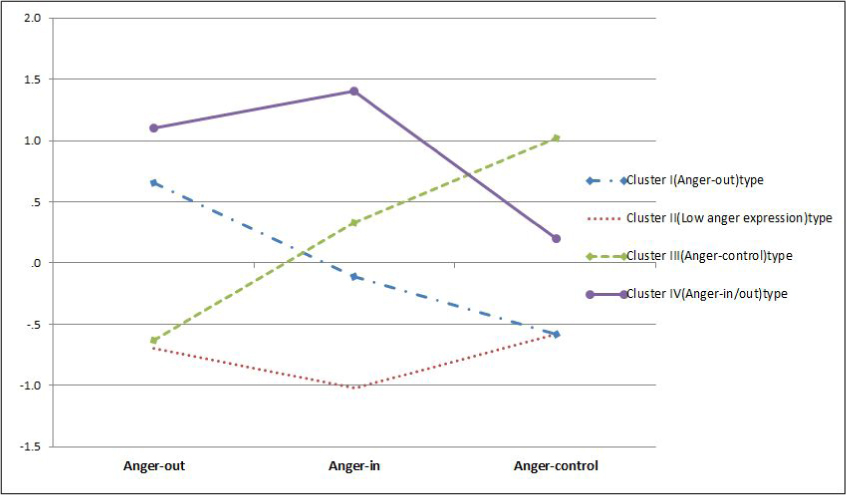Korean J Women Health Nurs.
2015 Jun;21(2):128-138. 10.4069/kjwhn.2015.21.2.128.
Anger, Anger Expression Types, Problem Behaviors, and Suicide Probability in Adolescent Women using Cluster Analysis
- Affiliations
-
- 1Department of Nursing, Mokpo National University, Muan, Korea.
- 2College of Nursing, Kosin University, Busan, Korea. hhuna@kosin.ac.kr
- KMID: 2307926
- DOI: http://doi.org/10.4069/kjwhn.2015.21.2.128
Abstract
- PURPOSE
This cross-sectional study was designed to identify anger-expression types of adolescent women and investigate the relationship between the identified anger-expression types and their problem behaviors and suicide probability.
METHODS
The participants were 942 students at two female high school located in Gwangju. The data were analyzed using descriptive statistics, cluster analysis, t-test, ANOVA, and Scheffe multiple comparison test.
RESULTS
Cluster analysis revealed 4 distinct anger expression types; Anger-out, Low anger expression, Anger-control, and Anger-in/out types. Female adolescent women had a higher level of trait anger or who frequently used the anger-in/out type reported internalized-externalized problem behaviors and suicide probability more frequently compared to those who frequently used the other three types of anger expression.
CONCLUSION
Female adolescent women who had the low anger expression type and anger control type managed anger most effectively. The findings suggest the necessity of a development of the program for lowering the trait anger level and controlling the unfavorable anger expression types such as the anger-in/out.
Keyword
Figure
Reference
-
1. Korea National Statistical Office. Annual report of the cause of death statistics [Internet]. Daejeon: Korea National Statistical Office;2012. cited 2014 June 27. Available from: http://kosis.kr/ups/ups_01List01.jsp?pubcode=YD.2. Lee YS, Cho JY. A standardization study of the Korean version of the adolescent's state-trait anger expression inventory. J Korean Neuropsychiatr Assoc. 1999; 38(4):794–804.3. Lee JE, Choi DW, Lim JH. Construction of a structural model about middle school students' anger, depression, and suicidal ideation. J Korean Soc Sch Health. 2013; 26(2):72–80.4. Park YJ, Han KS, Shin HJ, Kang HC, Moon SH. Anger, problem behaviors, and health status in adolescent women. J Korean Acad Nurs. 2004; 34(7):1234–1242.
Article5. Daniel SS, Goldston DB, Erkanli A, Franklin JC, Mayfield AM. Trait anger, anger expression, and suicide attempts among adolescents and young adults: A prospective study. J Clin Child Adolesc Psychol. 2009; 38(5):661–671.
Article6. Yoon HM, Park BK. Factors associated with adolescents' problem behaviors. Korean J Soc Welf Stud. 2005; 28:133–164.7. Lee JY. The psychosocial characteristics of suicidal ideators for children: Problem behaviors, self-esteem, social skills and adaptation to school life. Korean J Couns. 2004; 5(1):163–175.8. Korea Centers for Disease Control and Prevention. Reports on the Korea youth risk behavior web-based survey 2006. Seoul, Korea: Korea Centers for Disease Control and Prevention;2007.9. Brent DA, Baugher M, Bridge J, Chen T, Chiappetta L. Age- and sex-related risk for adolescent suicide. J Am Acad Child Adolesc Psychiatry. 1999; 38(12):1497–1505.10. Spielberger CD. Professional manual for the state-trait anger expression inventory (STAXI). Odessa FL: Psychological Assessment Resources;1988.11. Achenbach TM. Manual for the youth self-report and 1991 profile. Burlington: Department of Psychiatry, University of Vermont;1991.12. Oh KJ, Lee HL, Hong KE, Ha EH. Korea-child behavior checklist (K-CBCL). Seoul: ChungAng Aptitude Publishing;1997.13. Jang DH. The influences of family violence experience type on children's emotional, behavioral and social maladjustment. Korean J Youth Stud. 2004; 11(3):65–91.14. Cull JG. Suicide probability scale (SPS) manual. Los Angeles, CA: Western Psychological Services;1982.15. Go HJ, Kim DJ, Lee HP. A validation study of the suicide probability scale for adolescence (SPS-A). J Korean Neuropsychiatr Assoc. 2000; 39(4):680–690.16. West SG, Finch JF, Curran PJ. Structural equation models with nonnormal variables: Problem and remedies. In : Hoyle RH, editor. Structural equation modeling: Concepts, issues, and applications. Newbury Park, CA: Sage;1995.17. Hair JF, Black WC. Cluster analysis. In : Grimm LG, Yarnold PR, editors. Reading and understanding more multivariate statistics. Washington, DC: APA;2000.18. Kim HS, Chae YS, Bae YJ. The protective factors of suicide probability in religious male high school students. J Korean Acad Nurs. 2012; 42(1):1–8.
Article19. Park YJ, Ryu H, Han KS, Kwon JH, Kim HK, Kang HC, et al. Anger, anger expression, and suicidal ideation in Korean adolescents. Arch Psychiatr Nurs. 2010; 24(3):168–177.
Article20. Yi SG, Yi YJ, Jung HS. Factors on the suicidal attempt by gender of middle and high school student. J Korean Acad Nurs. 2011; 41(5):652–662.
Article21. Cautin RL, Overholser JC, Goetz P. Assessment of mode of anger expression in adolescent psychiatric inpatients. Adolescence. 2001; 36(141):163–170.22. Gross JJ, John OP. Individual differences in two emotion regulation processes: Implications for affect, relationships, and well-being. J Pers Soc Psychol. 2003; 85(2):348–362.
Article23. Boergers J, Spirito A, Donaldson D. Reasons for adolescent suicide attempts: Associations with psychological functioning. J Am Acad Child Adolesc Psychiatry. 1998; 37(12):1287–1293.
Article24. Zhang P, Roberts RE, Liu Z, Meng X, Tang J, Sun L, et al. Hostility, physical aggression and trait anger as predictors for suicidal behavior in Chinese adolescents: A school-based study. Plos One. 2012; 7(2):e31044.
Article
- Full Text Links
- Actions
-
Cited
- CITED
-
- Close
- Share
- Similar articles
-
- Anger, Problem Behaviors, and Health Status in Adolescent Women
- Relation of Self-reported Attachment Style, Trait Anger and Anger Expression in Adolescent Women
- The Relation of Trait anger and Anger Expression to Cardiovascular Responses and Depression in Middle-aged Korean Women
- A Study of the Relationship between Anger Thought And Problem Behavior in Perfectionist High School Girls
- Anger Expression Type and Mental Health in Middle Aged Women


